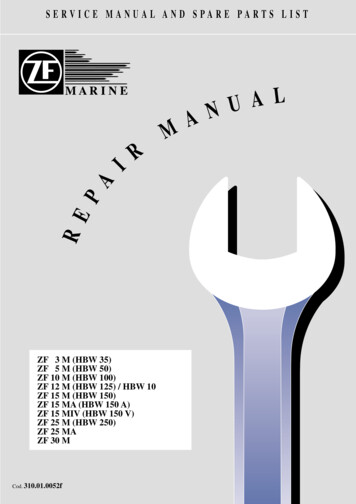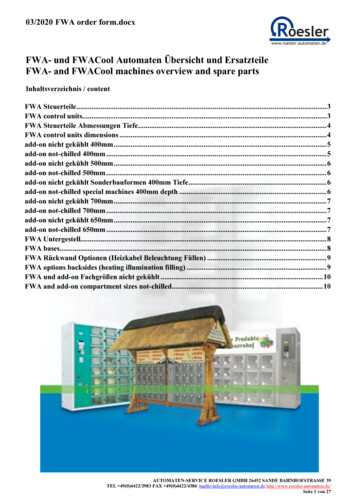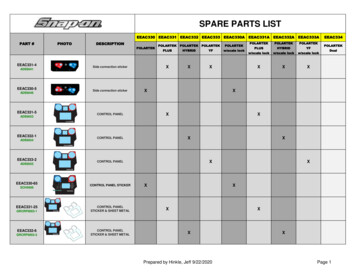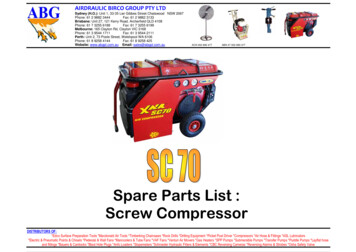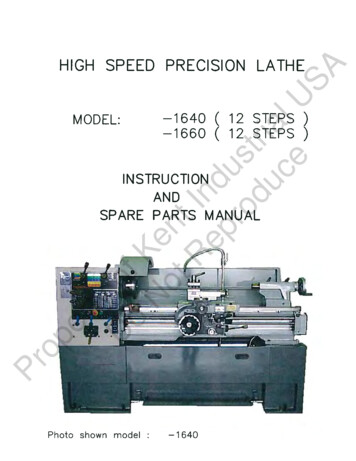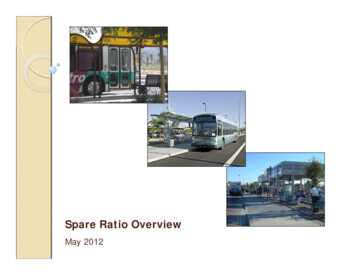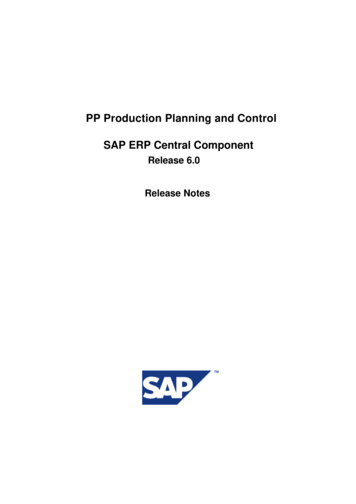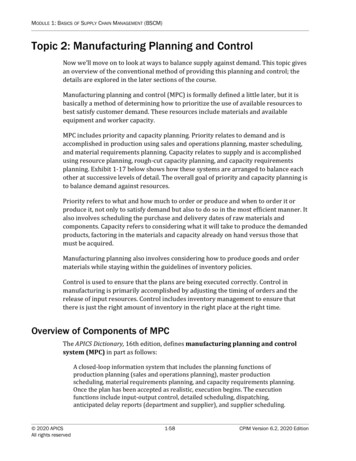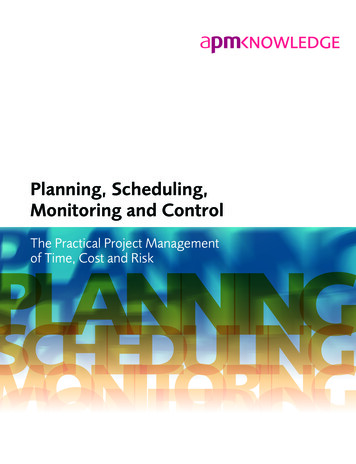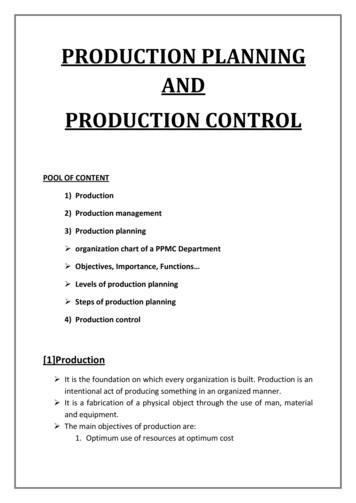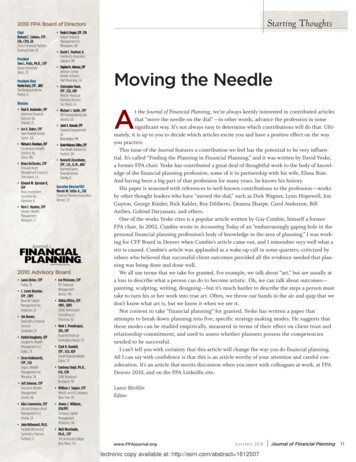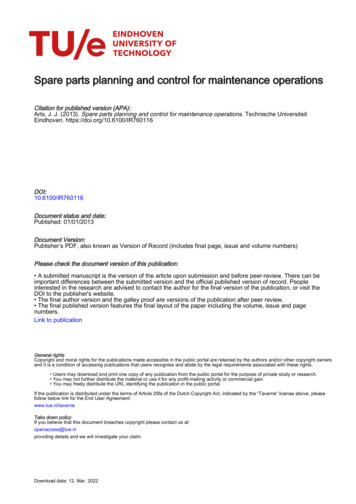
Transcription
Spare parts planning and control for maintenance operationsCitation for published version (APA):Arts, J. J. (2013). Spare parts planning and control for maintenance operations. Technische UniversiteitEindhoven. 16Document status and date:Published: 01/01/2013Document Version:Publisher’s PDF, also known as Version of Record (includes final page, issue and volume numbers)Please check the document version of this publication: A submitted manuscript is the version of the article upon submission and before peer-review. There can beimportant differences between the submitted version and the official published version of record. Peopleinterested in the research are advised to contact the author for the final version of the publication, or visit theDOI to the publisher's website. The final author version and the galley proof are versions of the publication after peer review. The final published version features the final layout of the paper including the volume, issue and pagenumbers.Link to publicationGeneral rightsCopyright and moral rights for the publications made accessible in the public portal are retained by the authors and/or other copyright ownersand it is a condition of accessing publications that users recognise and abide by the legal requirements associated with these rights. Users may download and print one copy of any publication from the public portal for the purpose of private study or research. You may not further distribute the material or use it for any profit-making activity or commercial gain You may freely distribute the URL identifying the publication in the public portal.If the publication is distributed under the terms of Article 25fa of the Dutch Copyright Act, indicated by the “Taverne” license above, pleasefollow below link for the End User Agreement:www.tue.nl/taverneTake down policyIf you believe that this document breaches copyright please contact us at:openaccess@tue.nlproviding details and we will investigate your claim.Download date: 12. Mar. 2022
Spare Parts Planning and Controlfor Maintenance Operations
This thesis is number D175 of the thesis series of the Beta Research School forOperations Management and Logistics. The Beta Research School is a joint effortof the School of Industrial Engineering and the department of Mathematics andComputer Science at Eindhoven University of Technology, and the Center forProduction, Logistics and Operations Management at the University of Twente.A catalogue record is available from the Eindhoven University of Technology Library.ISBN: 978-90-386-3475-3Printed by Proefschriftmaken.nl Uitgeverij BOXPressCover Design by Roy Lurken - BureauNobelThis research has been funded by NedTrain.
Spare Parts Planning and Controlfor Maintenance OperationsPROEFSCHRIFTter verkrijging van de graad van doctor aan deTechnische Universiteit Eindhoven, op gezag van derector magnificus, prof.dr.ir. C.J. van Duijn, voor eencommissie aangewezen door het College voorPromoties in het openbaar te verdedigenop maandag 11 november 2013 om 16.00 uurdoorJoachim Jacob Artsgeboren te Eindhoven
Dit proefschrift is goedgekeurd door de promotoren en de samenstelling van depromotiecommissie is als volgt:voorzitter:1e promotor:2e promotor:leden:prof.dr. A.G.L. Rommeprof.dr.ir. G.J.J.A.N. van Houtumprof.dr. A.G. de Kokprof.dr.ir. O.J. Boxmaprof.dr.ir. L.A.M. van Dongen (Universiteit Twente)prof.dr. R. Levi (Massachusetts Institute of Technology)prof.dr. S. Minner (Technische Universität München)prof.dr. C. Witteveen (Technische Universiteit Delft)
AcknowledgmentsAlthough this thesis has only one author, it is in fact the result of contributions bymany people.First I would like to thank my first promotor Geert-Jan van Houtum for his supervisionand support. He taught me the tricks of the research trade as well as how to navigatethe academic world. He made sure all the research fitted in a larger perspective whilealso helping out with details and technicalities.I would like to thank NedTrain for funding my PhD research. Working in themaintenance development department of NedTrain under the supervision of BobHuisman was a great pleasure. Bob Huisman created the perfect environment wherepractice and research could meet. Apart from being involved with the particularsof research, he also has a keen eye for the human aspect of the research endeavor.I also thank Michel Wilson and Jorge Parada for our joint discussions on researchand applications at NedTrain. I thank Leo van Dongen for leading this collaborationbetween NedTrain and academia, and for chairing the steering committee of thiscollaboration. I also thank him for his input during meetings of the steering committeeand for being on my thesis committee.At NedTrain, I am also indebted to Joost Florie and Guido Aerts for their input onmodeling issues and for acquainting me with the particulars of NedTrain’s supplychain and repair shop operations.I thank Maarten Driessen for our collaboration on Chapter 2 of this thesis. I enjoyedour many conversations on how to apply scientific knowledge in practice. I also thankKristina Sharypova for tolerating such lengthy conversations in our office, bringing apleasant atmosphere to the office, and reminding us of the more important things inlife.I would like to thank Simme Douwe Flapper for our collaboration on Chapter 3.Chapter 3 has also benefited from the graduation projects of Karin Vernooij, AnneBasten, and Martine Rousseau.I thank Rob Basten for being my daily supervisor when he was in Eindhoven and hiscontributions to Chapter 4 of this thesis. Rob Basten, together with Frank Karstenand Willem van Jaarsveld, have provided the necessary feedback and reflection onacademic life.Chapter 5 of this thesis has benefited from the master thesis projects of Martijn vanAspert and Nadine Loeffen.I would like to thank Retsef Levi for hosting my visit to MIT and our joint work
on Chapter 6 of this thesis. In his busy schedule, he managed to free time for ourcollaboration and he was always very sharp during our meetings. Working at theOperations Research Center at MIT was truly stimulating. I would also like to thankmy sister Saskia and her husband John for letting me and my family stay at theirhome and otherwise making our stay in the greater Boston area a pleasant experience.My visit to MIT was partially funded by the Prins Bernhard Fellowship supportedby the De Breed Kreiken innovation fund.Ton de Kok became my second promotor somewhat late in my PhD project, but hasshown an active interest in my work from the beginning. I really enjoyed our manyconversations on very diverse topics.I thank Onno Boxma, Stefan Minner, and Cees Witteveen for being on my thesiscommittee and their valuable feedback on my work.Qiushi Zhu was my office mate for almost three years. We had some great laughs andhe was always patient enough to hear the boring details of my research problems.I thank all my current and former colleagues at the OPAC department for the goodatmosphere and tea breaks. In particular, Claudine made for an excellent atmospherein the E-corridor and she helped with many planning en technical problems (in thenon-mathematical sense).When I was young, my parents taught me the value of getting a good education. Ithank them for supporting me all the way to a PhD degree. My siblings were veryinfluential in shaping my ideas about the quest for truth and the role of academicresearch in this quest.Doing a PhD can put quite some strain on family life and I thank my wife Heidi forsupporting me in ways too numerous to mention. She performed a very thoroughproofreading of the entire thesis and carefully checked my algebra when I was doing along derivation and needed a second pair of eyes. My two sons were also instrumentalin the moral support needed to complete a thesis. They make a short appearance inChapter 5.Finally, I thank my Father in heaven for his support in all things.
Contents1 Introduction1.1 Maintenance operations . . . . . . . . . . . . . . . . . . . . . . . . . .1.1.1 Maintenance strategies . . . . . . . . . . . . . . . . . . . . . . .1.1.2 Uncertainty in maintenance operations . . . . . . . . . . . . . .1.1.3 Spare parts in maintenance operations . . . . . . . . . . . . . .1.1.4 Maintenance operations at NedTrain . . . . . . . . . . . . . . .1.2 Spare part supply chains . . . . . . . . . . . . . . . . . . . . . . . . . .1.2.1 Repair and overhaul shops . . . . . . . . . . . . . . . . . . . . .1.2.2 Performance measures . . . . . . . . . . . . . . . . . . . . . . .1.2.3 Spare part supply chain at NedTrain . . . . . . . . . . . . . . .1.3 Research objectives . . . . . . . . . . . . . . . . . . . . . . . . . . . . .1.3.1 Framework . . . . . . . . . . . . . . . . . . . . . . . . . . . . .1.3.2 Rotables, usage based maintenance and efficient utilization ofresources . . . . . . . . . . . . . . . . . . . . . . . . . . . . . .1.3.3 Repairables, condition based maintenance, and repair lead timeflexibility . . . . . . . . . . . . . . . . . . . . . . . . . . . . . .1.3.4 Consumables, emergency procedures . . . . . . . . . . . . . . .1.4 Contributions of the thesis . . . . . . . . . . . . . . . . . . . . . . . . .1.4.1 Rotable overhaul planning . . . . . . . . . . . . . . . . . . . . .1.4.2 Repairable stocking and expediting under fluctuating demand .1.4.3 Consumable stocking with emergency shipments . . . . . . . .1.5 Outline of the thesis . . . . . . . . . . . . . . . . . . . . . . . . . . . .131414141618192 Maintenance spare parts planning framework2.1 Introduction . . . . . . . . . . . . . . . . . . . . . . . . . . . .2.2 Characterization of the environment . . . . . . . . . . . . . .2.2.1 Characterization of system maintenance . . . . . . . .2.2.2 Maintenance spare parts supply chain overview . . . .2.2.3 Demand characteristics of maintenance spare parts . .2.3 Framework for maintenance spare parts planning and control2.3.1 Assortment management . . . . . . . . . . . . . . . . .2121242426282829.1446799101111121212
2.42.52.3.2 Demand forecasting . . . . . . . . . . .2.3.3 Parts returns forecasting . . . . . . . . .2.3.4 Supply management . . . . . . . . . . .2.3.5 Repair shop control . . . . . . . . . . .2.3.6 Inventory control . . . . . . . . . . . . .2.3.7 Spare parts order handling . . . . . . .2.3.8 Deployment . . . . . . . . . . . . . . . .Framework related literature and open research2.4.1 Assortment management literature . . .2.4.2 Demand forecasting literature . . . . . .2.4.3 Parts returns forecasting literature . . .2.4.4 Supply management literature . . . . .2.4.5 Repair shop control literature . . . . . .2.4.6 Inventory control literature . . . . . . .2.4.7 Spare parts order handling literature . .2.4.8 Literature overview . . . . . . . . . . . .Concluding remarks . . . . . . . . . . . . . . . . . . . . . . . . . . . . . . . . . . . .topics. . . . . . . . . . . . . . . . . . . . . . . . . . . .3 Rotable overhaul and supply chain planning3.1 Introduction . . . . . . . . . . . . . . . . . . . . . . . . .3.2 Literature review and contribution . . . . . . . . . . . .3.2.1 Preventive maintenance and capacity planning .3.2.2 Aggregate production and supply chain planning3.2.3 Contribution . . . . . . . . . . . . . . . . . . . .3.3 Model . . . . . . . . . . . . . . . . . . . . . . . . . . . .3.3.1 Supply chain dynamics . . . . . . . . . . . . . . .3.3.2 Workforce capacity and flexibility in the overhaul3.3.3 Rotable availability . . . . . . . . . . . . . . . . .3.3.4 Overhaul deadlines propagation . . . . . . . . . .3.3.5 Cost factors . . . . . . . . . . . . . . . . . . . . .3.3.6 Model remarks . . . . . . . . . . . . . . . . . . .3.3.7 Mixed integer programming formulation . . . . .3.3.8 Modeling flexibility . . . . . . . . . . . . . . . . .3.4 Case study . . . . . . . . . . . . . . . . . . . . . . . . .3.4.1 Computational feasibility . . . . . . . . . . . . .3.4.2 Sensitivity of result to integrality constraints . .3.4.3 Insights from case-study . . . . . . . . . . . . . .3.5 Numerical results for randomly generated instances . . .3.5.1 Random instance generator . . . . . . . . . . . .3.5.2 Results . . . . . . . . . . . . . . . . . . . . . . .3.6 Conclusion . . . . . . . . . . . . . . . . . . . . . . . . . . . . . . . . . . . . . . . . . . . . . . . . . . . . . . . . . . . .workshop. . . . . . . . . . . . . . . . . . . . . . . . . . . . . . . . . . . . . . . . . . . . . . . . . . . . . . . . . . . . . . . . . . . . . . 60626363646567686970717375757780
3.A Proof of Proposition 3.2 . . . . . . . . . .3.B Details on the random instance generator3.B.1 Rotable characteristics . . . . . . .3.B.2 Initial conditions and flexibility . .3.B.3 Costs parameters . . . . . . . . . .81828283834 Repairable stocking and expediting4.1 Introduction . . . . . . . . . . . . . . . . . . . . . . . . . . . . . . .4.2 Literature review . . . . . . . . . . . . . . . . . . . . . . . . . . . .4.3 Model formulation . . . . . . . . . . . . . . . . . . . . . . . . . . .4.3.1 Main assumptions and justifications . . . . . . . . . . . . .4.4 Exact Analysis . . . . . . . . . . . . . . . . . . . . . . . . . . . . .4.4.1 Expediting policy optimization . . . . . . . . . . . . . . . .4.4.2 Turn-around stock optimization . . . . . . . . . . . . . . . .4.5 E-WDT Heuristic . . . . . . . . . . . . . . . . . . . . . . . . . . . .4.5.1 World driven threshold policies . . . . . . . . . . . . . . . .4.5.2 Heuristic optimization of the turn-around stock:The E-WDT heuristic . . . . . . . . . . . . . . . . . . . . .4.6 Numerical results . . . . . . . . . . . . . . . . . . . . . . . . . . . .4.6.1 Test bed and set-up . . . . . . . . . . . . . . . . . . . . . .4.6.2 Performance of the WDT policy for fixed turn-around stock4.6.3 Performance of the E-WDT heuristic . . . . . . . . . . . . .4.6.4 Value of anticipating demand fluctuations . . . . . . . . . .4.7 Conclusion . . . . . . . . . . . . . . . . . . . . . . . . . . . . . . .y4.A Determining P{Dt,t k} . . . . . . . . . . . . . . . . . . . . . .e4.B Proofs . . . . . . . . . . . . . . . . . . . . . . . . . . . . . . . . . .4.B.1 Proof of Lemma 4.1 . . . . . . . . . . . . . . . . . . . . . .4.B.2 Proof of Proposition 4.1 (ii) . . . . . . . . . . . . . . . . . .4.B.3 Proof of Lemma 4.2 . . . . . . . . . . . . . . . . . . . . . .4.B.4 Proof of Lemma 4.4 . . . . . . . . . . . . . . . . . . . . . .85. 85. 89. 90. 92. 94. 94. 104. 107. 108.1101111111131151161181201211211211241265 A system approach to repairable stocking and expediting5.1 Introduction . . . . . . . . . . . . . . . . . . . . . . . .5.2 Literature review and contribution . . . . . . . . . . .5.2.1 Fluctuating demand . . . . . . . . . . . . . . .5.2.2 Expediting and repair scheduling policies . . .5.2.3 Decomposition and column generation . . . . .5.3 Model . . . . . . . . . . . . . . . . . . . . . . . . . . .5.3.1 Notation and preliminaries . . . . . . . . . . .5.3.2 Control policy . . . . . . . . . . . . . . . . . .5.3.3 Markov Modulated demand models and fitting.129129131131132133134134136139.
5.3.4 Optimization problem . . . . . . . . . . . . . . . .Analysis . . . . . . . . . . . . . . . . . . . . . . . . . . . .5.4.1 Constructing lower bounds with column generation5.4.2 Constructing a good feasible solution . . . . . . . .5.5 Computational results . . . . . . . . . . . . . . . . . . . .5.5.1 Objectives and test bed . . . . . . . . . . . . . . .5.5.2 Results . . . . . . . . . . . . . . . . . . . . . . . .5.6 Conclusion . . . . . . . . . . . . . . . . . . . . . . . . . .5.A Proof of Proposition 5.1 . . . . . . . . . . . . . . . . . . .5.46 Base-stock policies for consumables6.1 Introduction . . . . . . . . . . . . . . . . . . . .6.2 Model . . . . . . . . . . . . . . . . . . . . . . .6.3 State space aggregation . . . . . . . . . . . . .6.4 Asymptotics . . . . . . . . . . . . . . . . . . . .6.5 Rates of convergence . . . . . . . . . . . . . . .6.6 Internal consistency: flow conservation . . . . .6.7 Extensions . . . . . . . . . . . . . . . . . . . . .6.7.1 General single period cost functions . .6.7.2 Service level constraints . . . . . . . . .6.8 Numerical results . . . . . . . . . . . . . . . . .6.9 Conclusion . . . . . . . . . . . . . . . . . . . .6.A Proofs . . . . . . . . . . . . . . . . . . . . . . .6.A.1 Proof of Proposition 6.1 . . . . . . . . .6.A.2 Proof of Theorem 6.4 . . . . . . . . . .6.A.3 Derivation of the state space size of Qt6.B The generalized Pareto distribution . . . . . . .6.C Tables with details per instance . . . . . . . . 1691691691701761771771781791791807 Conclusion7.1 Research objectives revisited . . . . . . . . . . . . . . . . . . . . . . .7.1.1 Framework . . . . . . . . . . . . . . . . . . . . . . . . . . . . .7.1.2 Rotables, usage based maintenance and efficient utilization ofresources . . . . . . . . . . . . . . . . . . . . . . . . . . . . . .7.1.3 Repairables, condition based maintenance, and repair lead timeflexibility . . . . . . . . . . . . . . . . . . . . . . . . . . . . . .7.1.4 Consumables, emergency procedures . . . . . . . . . . . . . . .193193193Bibliography197Summary211194195196
About the author217
Chapter 1Introduction“The whole is more than the sumof its parts”AristotleInterchangeable parts have revolutionized modern manufacturing. Before the industrial revolution, products were made one-by-one as a whole in workshops by craftsmen.After the industrial revolution and up until today, most products are assembledfrom interchangeable parts. Recent research identifies the French General JeanBaptiste de Gribeauval as the principal originator of working with interchangeableparts (Hounshell, 1984). He introduced a system for constructing French artillery frominterchangeable parts in 1765. His system became known as “le système Gribeauval”.Thomas Jefferson1 was introduced to le système Gribeauval in 1785 when he was inFrance as a diplomat, and visited the weapon workshop of Honeré Blanc who wasa gunsmith implementing le système Gribeauval. In a letter to John Jay2 , ThomasJefferson wrote about this visit:An improvement is made here in the construction of the musket which itmay be interesting to Congress to know, should they at any time proposeto procure any. It consists in the making every part of them so exactlyalike that what belongs to any one may be used for any other musketin the magazine. The government here has examined and approved the1 ThomasJefferson (1743-1826) is a founding father of the United States of America, its thirdpresident, and one of the principal authors of the declaration of independence.2 John Jay (1745-1829) is a founding father of the United States of America and the first ChiefJustice of the United States
2Chapter 1. Introductionmethod, and is establishing a large manufactory for this purpose. As yetthe inventor3 has only completed the lock of the musket on this plan. Hewill proceed immediately to have the barrel, stock and their parts executedin the same way. Supposing it might be useful to the U.S. I went to theworkman. He presented me with the parts of 50 locks taken to pieces andarranged in compartments. I put several together myself taking pieces athazard as they came to hand, and they fitted in the most perfect manner.The advantages of this, when arms need repair, are evident.4Interchangeable parts enabled the industrial revolution in large measure because theyenabled the division of labor (Smith, 1776) and therefore raised productivity. Inthe time of Thomas Jefferson however, producing muskets with interchangeable partslowered productivity because it required resolving several metrological issues in orderto make the parts truly interchangeable. Jefferson was aware of this; the advantagehe saw, as is evident in his last sentence above, was in the repair and maintenance ofthe muskets after production on the battlefield. In fact, years later, Thomas Jeffersonwrote to the secretary of war, Henry Knox5 , that Blanc’s:.method of forming the firearms appears to me so advantageous, whenrepairs become necessary, that I have thought it my duty not only tomention to you the progress of this artist6 , but to purchase and send youhalf a dozen of his officers fusils.7The use of interchangeable parts and the division of labor continued to enable themass production that has shaped modern society. It appears that the main reason topursue the use of interchangeable parts, at least for Thomas Jefferson, was to facilitatemaintenance operations. This was despite the fact that in the short run, producingwith interchangeable parts was more expensive because the industrial metrologytechnology needed to make truly interchangeable parts had not yet been developed.This is striking: One of the most revolutionary ideas of modern manufacturing startedout as a maintenance innovation!This maintenance innovation also changed maintenance operations. Rather thanperforming maintenance or repair on equipment in its entirety, parts of equipmentthat require maintenance or repair are interchanged with ready-for-use spare parts.3 ThomasJefferson here refers to Honoré Blancof Thomas Jefferson, 8:455, August 30 17855 Henry Knox (1750-1806) was an officer, initially in the continental army during the Americanrevolutionary war, and later in the United States army. Under the US presidency of GeorgeWashington, he was the secretary of war.6 Thomas Jefferson is again referring to Honoré Blanc7 Papers of Thomas Jefferson, 15:422, September 12 17894 Papers
3After this, the equipment returns to serviceable condition immediately, while repairand maintenance is conducted on the replaced parts. This method for maintainingequipment greatly increases the availability of equipment. Since equipment oftenrepresents substantial financial investments (just think of aircraft, rolling stock,MRI-scanners and military equipment) achieving a high availability of equipmentis important. Spare parts are essential in ensuring proper operation of this systemof maintenance by replacing parts, and so they also affect daily services provided byequipment such as public transportation (rolling stock, aircraft) health care (MRIscanners), and military operations (military equipment and weapon systems). Theplanning and control of spare parts for the support of maintenance operations is thetopic of this thesis.Maintenance spare parts planning and control also has a significant financial impact.Some impressive statistics that illustrate this are: In 2003, spare parts sales and services (mostly maintenance) accounted for 8%of the gross domestic product in the United States (AberdeenGroup, 2003). More recently, US bancorp estimated that the yearly expenditure in the US onspare parts amounts to 700 billion dollars which is 8% of the US gross domesticproduct (Jasper, 2006). A study by Deloitte (2006) among 120 large manufacturing companies in NorthAmerica, Asia Pacific and Europe shows that service revenues represent morethan 25% of total business. According to the same study by Deloitte (2006), aftermarket service and sparepart sales account for 40% of profits for these 120 manufacturing companies.Another indicator of the importance of spare parts and after sales services andmaintenance is that original equipment manufacturers (OEMs) are increasinglyrealizing the potential, and are making a business model out of providing after salesservices (Oliva and Kallenberg, 2003; Wise and Baumgartner, 1999). Nevertheless, inthis thesis, we take the perspective of the owner of equipment that decides to keepmaintenance and spare parts planning in house.In the remainder of this introductory chapter, we discuss the industrial setting forwhich the models in this thesis have been developed. We start by giving a briefoverview of maintenance operations and the supply chain of maintenance spareparts in §1.1 and §1.2. Here and throughout the thesis, we take the perspective ofowner/maintainer of equipment rather than that of an OEM providing maintenancefor its customers. We identify several issues that arise in the planning and control ofmaintenance spare parts and formulate the research objectives of this thesis in §1.3.We conclude this chapter by giving an outline of the thesis in §1.5.
4Chapter 1. Introduction1.1.Maintenance operationsDifferent from regular production operations, maintenance operations are not instigated by demand from an outside customer, but by the need for maintenance ofequipment. To perform maintenance, typically several resources are needed, the mostimportant of which are: a specialist, mechanic, engineer or other trained professional tools and equipment spare parts.In §1.1.1, we discuss different maintenance strategies and how they instigate the needfor maintenance operations (and therefore also the resources mentioned above). Theplanning difficulties that arise in maintenance operations are discussed in §1.1.2. Therole of spare parts in maintenance operations is discussed in §1.1.3. By way of example,we conclude with a brief description of actual maintenance operations at NedTrain.1.1.1Maintenance strategiesFor the purpose of describing maintenance operations, it is convenient to think ofequipment as a collection of interrelated parts. Maintenance operations consist largely(but not solely) in replacing parts of equipment. Maintenance strategies determinewhen parts or equipment need to be replaced or maintained. Throughout thissubsection, we focus on the decision to maintain/replace a part, but our discussion alsoapplies to the decision to maintain/replace equipment. Figure 1.18 gives an overviewof maintenance strategies. In this subsection, we follow Figure 1.1 in discussingdifferent maintenance strategies.Modificative maintenance concerns interchanging a part with a technically moreadvanced part in order to make the equipment perform better9 . This form ofmaintenance is usually project based and non-recurring. The maintenance strategiesthat occur most often are preventive and breakdown corrective maintenance. Undera breakdown corrective maintenance strategy, a part is not replaced until it hasfailed, while under a preventive maintenance strategy, the aim is to replace partsbefore failure occurs. (Off course, this aim may not always be achieved: A part canbreak down before its replacement occurs.) Breakdown corrective maintenance is an8 Figure 1.1 was inspired by Figure 4.1 of Coetzee (1997), but has been significantly altered bythe author.9 Sometimes maintenance is defined as any action that restores equipment to some previous state.Under this definition, modificative maintenance is an oxymoron.
1.1 Maintenance nancePreventivemaintenanceBreakdown correctivemaintenanceUsage basedmaintenanceComponent replacementand/or overhaulCondition basedmaintenanceBlock replacementand/or re 1.1 Maintenance strategiesattractive option for parts that do not wear, such as electronics. For parts that dowear, it can be beneficial to follow a preventive maintenance strategy.Preventive maintenance strategies can be further divided into usage and conditionbased maintenance. Under usage based maintenance, the total usage of a part ismeasured and maintenance is conducted when a certain threshold level has beenreached. The usage of parts can be measured in many ways depending on the nature ofthe equipment. Time in the field is perhaps the most common mean to measure usage.For vehicles (e.g., rolling stock), mileage is a common measure of usage. The numberof on-off cycles is a measure of usage for equipment that is mainly loaded at the end orbeginning of on-off cycles. For example, the number of landings is a measure of usagefor the landing gear of an aircraft. Since the usage of equipment is usually scheduled,the moment that maintenance is performed can also be scheduled. If there is a largeset-up cost associated with maintenance, it can be beneficial to interchange severalparts simultaneously (Block replacement and/or overhaul). Otherwise, maintenancecan be performed on a single component (Component replacement and/or overhaul).In condition based maintenance, the actual condition of a part is gauged andmaintenance is conducted based on this. The condition of a part can be measured
6Chapter 1. Introductioneither periodically during inspections (Periodic inspections) or continuously through asensor (Condition monitoring). How the condition of equipment is measured dependson the nature of equipment. Below are some examples of how the condition ofequipment can be measured: The condition of ball-bearings can be measured via the amplitude of vibrationsaround the bearing (Elwany and Gebraeel, 2008). The condition of a metal part can be determined by visually inspecting thenumber and length of cracks. For metal systems with moving parts, the concentration of ferrous parts inthe lubrication fluid is measured as an indication of the wear and need forlubrication. The condition of a car engine is monitored continuously whi
This thesis is number D175 of the thesis series of the Beta Research School for Operations Management
